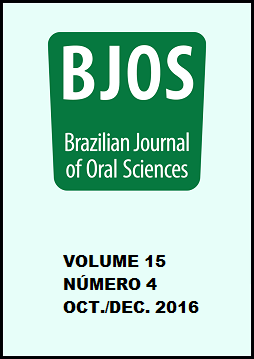Abstract
Pathogens of the oral cavity of a patient can be transferred to the dental office surfaces by direct contact, aerosol instruments and blood or saliva. The objective of this study was to investigate the microbiological contamination presents in the stands, chairs and spittoons in the University Nilton Lins dental clinics, in Manaus, Amazonas. Samples were collected with sterile swabs and seeded in different microbiological culture media for the isolation of microorganisms collected from each room. Then, assays were carried out for identification of strains isolated from each environment, such as: Gram stain, DNA purification, Amplification of 16s rRNA genes and sequencing. All these experiments were performed in the LBS / ILMD / FIOCRUZ. It was found 40 CFU / mL in the stands, 43 on the chairs and 47 in the spittoons and it was also possible to identify microorganisms like Klebsiella pneumoniae, Shigella sonnei and Staphylococcus aureus. The greatest number of CFUs was found in Clinic 3 and it was observed that the spittoon was the dental surface with the highest number of CFUs. Some of the bacterial species isolated are opportunists, suggesting that more severe biosecurity measures must be taken in order to prevent cross-infection.Pathogens of the oral cavity of a patient can be transferred to the dental office surfaces by direct contact, aerosol instruments and blood or saliva. The objective of this study was to investigate the microbiological contamination presents in the stands, chairs and spittoons in the University Nilton Lins dental clinics, in Manaus, Amazonas. Samples were collected with sterile swabs and seeded in different microbiological culture media for the isolation of microorganisms collected from each room. Then, assays were carried out for identification of strains isolated from each environment, such as: Gram stain, DNA purification, Amplification of 16s rRNA genes and sequencing. All these experiments were performed in the LBS / ILMD / FIOCRUZ. It was found 40 CFU / mL in the stands, 43 on the chairs and 47 in the spittoons and it was also possible to identify microorganisms like Klebsiella pneumoniae, Shigella sonnei and Staphylococcus aureus. The greatest number of CFUs was found in Clinic 3 and it was observed that the spittoon was the dental surface with the highest number of CFUs. Some of the bacterial species isolated are opportunists, suggesting that more severe biosecurity measures must be taken in order to prevent cross-infection.References
Ghosh S, Mallick SK. Microbial bofilm: contamination in dental chair unit. Ind Med Gaz. 2012 Oct;145(10):383-7.
Laheij AM, Kistler JO, Belibasakis GN, Välimaa H, de Soet JJ. Healthcare-associated viral and bacterial infections in dentistry. J Oral Microbiol. 2012;4:1-10. doi: 10.3402/jom.v4i0.17659.
Artini M, Scoarughi GL, Papa R, Dolci G, De Luca M, Orsini G et al. Specific anti cross-infection measures may help to prevent viral contamination of dental unit waterlines: A pilot study. Infection. 2008 Oct;36(5):467-71. doi: 10.1007/s15010-008-7246-5.
Alavian SM. Hepatitis C virus infection: Epidemiology, risk factors and prevention strategies in public health in I.R.IRAN. Gastroenterol Hepatol Bed Brench. 2010;3(1):5-14.
Dahiya P, Kamal R, Sharma V, Kaur S. “Hepatitis” – Prevention and management in dental practice. J Educ Health Promot. 2015 May 19;4:33. doi:10.4103/2277-9531.157188.
Castiglia P, Liguori G, Montagna MT, Napoli C, Pasquarella C, Bergomi M, et al. Italian multicenter study on infection hazards during dental practice: control of environmental microbial contamination in public dental surgeries. BMC Public Health. 2008 May 29;8:187. doi: 10.1186/14712458-8-187.
Pasquarella C, Veronesi L, Castiglia P, Liguori G, Montagna MT, Napoli C, et al. Italian multicentre study on microbial environmental contamination in dental clinics: a pilot study. Sci Total Environ 2010 Sep 1;408(19):404551. doi: 10.1016/j.scitotenv.2010.05.010
Umar D, Basheer B, Husain A, Baroudi K, Ahamed F, Kumar A. Evaluation of bacterial contamination in a clinical environment. J Int Oral Health 2015 Jan;7(1):53-5.
Cardoso CT, Pinto Júnior JR, Pereira EA, Barros LM, Freitas ABDA. [Contamination of composite resin tubes handled without a protective barrier]. Robrac. 2010;18(48):71-5. Portuguese.
Santos KO, Mobin M, Borba CM, Noleto IMS. [Isolation of fungi from dental radiographic equipment]. RGO. 2011;59(3):411-6. Portuguese.
Barreto ACB, Vasconcelos CPP, Girão CMS, Rocha MMNP, Mota OML, Pereira S LS. [Environmental contamination by aerosols during treatment using ultrasonic devices]. Periodontia. 2011;21(2):79-84. Portuguese.
Kumar S, Atray D, Paiwal D, Balasubramanyam G, Duraiswamy P, Kulkarni S. Dental unit waterlines: source of contamination and cross infection. J Hosp Infect. 2010 Feb;74(2):99-111. doi: 10.1016/j. jhin.2009.03.027.
Spolidorio P, Duque C. [Microbiology and General and Dental Immunology]. São Paulo: Artes Médicas; 2013. Portuguese.
Engelmann AI, Dal AA, Miura CSN, Bremm LL, Boleta-Cerantio DC. [Evaluation of procedures performed by suregen-dentists from Cascavel state of parana and surroundings for biossecurity control]. Odontol Clin Cient. 2010 Apr-Jun;9(2):161-5. Portuguese.
Zadoks RNW, van Leeuwen B, Kreft D, Fox LK, Barkema HW, Schukken YH, et al. Comparison of Staphylococcus aureus isolates from bovine and human skin, milking equipment, and bovine milk by phage typing, pulsed-field gel electrophoresis, and binary typing. J Clin Microbiol. 2002 Nov;40(11):3894-902.
Casamayor EO, Schäfer H, Bañeras L, Pedrós-Alió C, Muyzer G. Identification of and spatio-temporal differences between microbial assemblages from two neighboring sulfurous lakes: comparison by microscopy and denaturing gradient gel electrophoresis. Appl Environ Microbiol. 2000 Feb;66 (2):499-508.
Matsuki T, Watanabe K, Fujimoto J, Kado Y, Takada T, Matsumoto K, et al. Quantitative PCR with 16S rRNA gene targeted species-specific primers for analysis of human intestinal bifidobacteria. Appl Environ Microbiol. 2004 Jan;70(1):167-73.
Tenaillon O, Skurnik D, Picard B, Denamur E. The population genetics of commensal Escherichia coli. Nat Rev Microbiol. 2010;8:207-17.
Peleg AY, Hooper DC. Hospital-acquired infections due to Gramnegative bacteria. N Engl J Med. 2010. 362:1804-13. doi:10.1056/ NEJMra0904124.
Molinari JA. Infection control - its evolution to the current standard precautions. J Am Dent Assoc. 2003 May;134(5):569-74.
Chong SL, Lam YK, Lee FKF, Ramalingam L, Yeo ACP, Lim CC. Effect of various infection-control methods for light-cure units on the cure of composite resins. Oper Dent. 1998 Mar-Apr;23(3):150-4.
The Brazilian Journal of Oral Sciences uses the Creative Commons license (CC), thus preserving the integrity of the articles in an open access environment.

